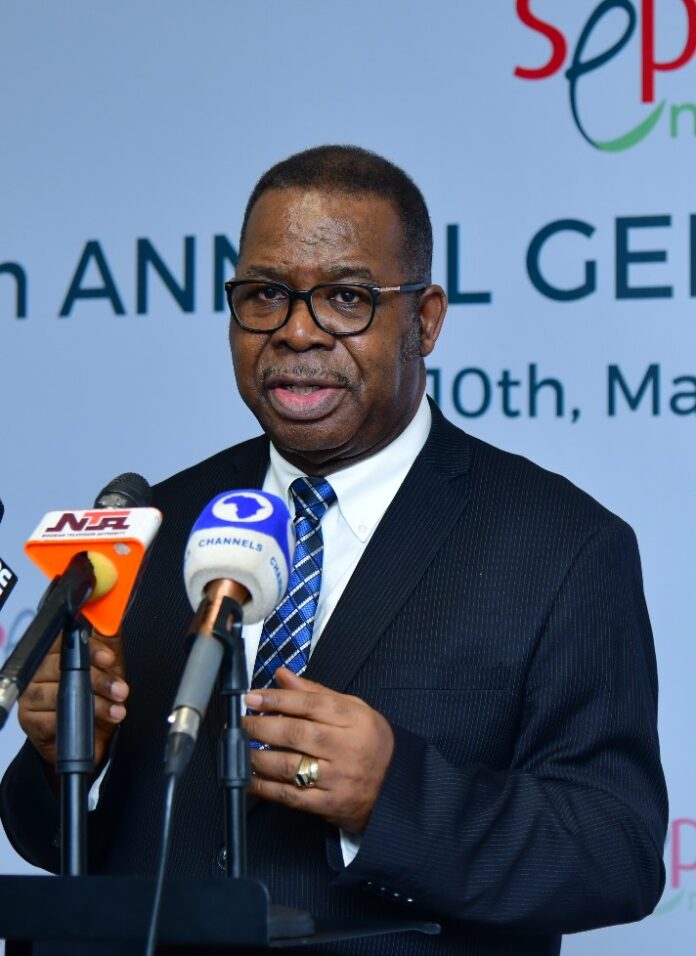DURING SEPLAT ENERGY PLC’S 10TH ANNUAL GENERAL MEETING MEDIA PARLEY, THE CHAIRMAN OF SEPLAT ENERGY PLC, MR. BASIL OMIYI, CON BARES HIS MIND.
Olushola Okunlade Writes
What would you attribute Seplat Energy’s very impressive 2022 full year business performance to?
Seplat Energy’s strategy is enabled by strong corporate governance and risk management, and built upon the values of safety, integrity, partnership, ambition, and agility.
In 2022, against a challenging environment of oil theft and outages on our export routes, the Company averaged 24,735 barrels of liquids a day for export and 112.3 MMscfd of processed natural gas for domestic power generation.
Also, higher global oil prices offset the impact of prolonged outages at the Forcados export route, which affected our oil exports in the third quarter of 2022. However, the long-awaited Amukpe-Escravos Pipeline finally came onstream to provide an alternative export route for our key assets.
Therefore, our cash generation was strong, as high oil prices offset lower production in 2022, depicting a huge value creation for all stakeholders.
Seplat Energy, in the 2022 business year, finalised the New Energy investment plan, and identified near-term opportunities for consideration and FID by late 2023. Can you throw more light on this?
Our New Energy investment plan is aimed at achieving a world-class capability in renewable energies, through the development or acquisition of new skillsets that open up new and profitable markets.
We have completed evaluation studies and finalised a ten-year integrated Gas and New Energy Investment Plan. Near-term opportunities we have identified in gas-to-power and solar energy will be subject to technical and business evaluation assessments, environment and social impact assessments, and project licensing, and we expect to move to FID before the end of 2023.
The key investment opportunities being considered include selective entry to off-grid power generation using gas-fired generation integrated with solar. Natural gas will be the mainstay of our energy transition programme and this, in turn, will ensure the sustainability and financial viability of the renewables programme.
We are also pursuing carbon offset possibilities on a wide range of emission reduction activities in various global carbon markets. The identified opportunities have considered advancement in technology, availability of resources within Nigeria, and feasibility of execution.
For the 2022 full year, the Board recommended a special dividend of US5.0 cents per share in addition to final dividend of US2.5 cents per share. What was the rationale behind this?
A special dividend of 5 cents was declared for 2022 following elevated realized oil prices and liquidity growth in the year. Furthermore, Seplat’s liquidity projections for 2023 remain positive given current oil price expectations.
The company has maintained a strong safety culture, recording just one LTI in October 2022 while LTIF for the full year is 0.12. What did Seplat Energy do differently in 2022?
I have to reemphasize that at Seplat Energy, we prioritise safety, which is a matter of both individual and collective responsibility.
As an energy company, we work in high-risk and sometimes challenging environments which puts a premium on safety, integrity, fairness and transparency. We aim to treat all those who work for us with respect and to develop the skills of our people. We believe this approach helps us manage and mitigate risks to our business.
The safety of all our employees, contractors, and local communities is a non-negotiable feature of our business. We continued to embed HSE imperatives across our operations; furthering our goal of an incident- and injury-free workplace, we have a mandatory ‘Safety Rules’ program that guides all our personnel and stakeholders in delivering a safe working environment for all.
For instance, during the year, we implemented an EMP for the Amukpe Buffer Storage Tanks project. The overall goal of the EMP for this project was to minimise the impact of various phases of the project activities on the environment, meet statutory obligations, and ensure the safety of personnel and members of the public while maintaining the economic and corporate goals of the company.
As Chairman of the Board, what is your message to all stakeholders given the Company’s very promising future?
As we progress on our journey to a more sustainable future, Seplat Energy will continue to evolve our business to develop a low-cost, lower-carbon, profitable, resilient, and diversified portfolio that will help us thrive in the globally transiting energy market. We remain committed to providing accessible and affordable energy. To this end, our business continues to demonstrate joint consideration of our people, the planet, and profits across all our operations
Continuous engagement with stakeholders is an integral part of our day-to-day business. Their support is a fundamental component of our ability to operate. The Board and senior leadership team recognise the need to invest in our relationships with stakeholders to deliver the Company’s goals. Through regular engagements, a variety of channels, and mechanisms, the company is able to understand the views of all stakeholders and integrates them in our decision-making process. Importantly, we use stakeholder engagement to help us identify and prioritise issues most material to the business.
The ANOH Gas Processing Plant is 95% mechanically complete, awaiting third-party infrastructure completion. What will be your message to investors?
I want to assure our investors that, once completed, ANOH will deliver two income streams for Seplat Energy: from OML 53’s wet gas sales to the plant, and from dividends returned to Seplat Energy from the joint venture ANOH Gas Processing Company, which will operate the plant. The upstream development, including the drilling of six production wells, will be delivered by the upstream unit operator SPDC. We expect the drilling of ANOH-03 and ANOH-04 by SPDC to be completed in Q2 2023.
We are a trusted partner to the Nigerian Government and other operators in the region. Our ANOH gas processing plant project is classed as strategically important for Nigeria, for which we are a leading supplier of gas for domestic power.
NGIC has confirmed that they expect the OB3 pipeline to be complete before the end of Q2 2023. Line pipes for the 23km spur line are in country and project completion is almost 70%, with the revised completion date communicated by NGIC as 30 June 2023. Despite estimated completion for the pipeline infrastructure being Q2 2023, we have further risked the completion dates and have moved the first gas to the final quarter of 2023.
Can you share the company’s roadmap as a sustainable energy business following the Board of Directors’ Succession Forward Plan announced on 25 April 2023?
As a Board, succession planning is a priority. Our approach to succession planning is not that of a box ticking exercise or a ‘nice to have.’
Our Board Succession Policy provides for selection criteria which accounts for current and future needs of the Company and its stakeholders, and that promotes diversity of thought. We recognize that a diverse board is better prepared for challenges that could arise and enables the Seplat Board in its ability to leverage different perspectives and think outside of the box; as opposed to a homogeneous board, which is likely to miss out on crucial elements of expertise and experience.
When considering candidates, the following qualities and competency elements are of prime importance to us – candidates who have proven experience in leading large, complex, international organisations. Such candidates would have had – significant experience in cost leadership; ability to balance the transformational changes that Seplat needs to make against the timing of these changes, particularly as the Company implements its energy transition objectives; demonstration of ability to implement the Company’s climate change agenda; and an understanding of the energy market.
Seplat Energy has commenced implementation of a roadmap to achieving net zero by 2050. Do you want to speak to this?
Our Flares Out project, which forms part of our commitment to achieving Net Zero by 2050, is on schedule to reach our target of ending routine flares by the end of 2024. In 2022, improvements in performance of the AG compressor in Oben and Amukpe, alongside regular asset integrity checks and other facility improvement activities, were effective and AG flare volume was reduced by 18.2% at Oben (5.7 MMscfd against 6.97 MMscfd in 2021) and by 39.9% at Amukpe (1.1 MMscfd against 1.83 MMscfd in 2021).
The Sapele Gas Plant (AG solution) with installed capacity of 40 MMscfd achieved mechanical completion in December. The AG solution is expected to process c.26 MMscfd and will make a significant contribution to flared gas utilisation, reducing emissions and carbon intensity.
In addition, we acquired an LDAR system at our Oben Gas Plant and trained 40 employees on use of the technology, which has enabled detection of invisible leaks and allowed our in-house O&M team to act promptly.
Our diesel replacement programme seeks to increase the use of gas, a less carbon intensive fuel for power generation and where feasible, solar power is also being considered. We are piloting solar at our Amukpe warehouse to power equipment on site and plan to power the security outposts located around our operations using solar energy in 2023.
Work is ongoing to spin out a Midstream Gas business in line with PIA provisions. Can you share the level of progress made in Seplat Energy with regards to this?
In line with the provisions of the PIA, we believe the Midstream Gas business could achieve a higher value when operated as a separate, standalone unit, independent of our Upstream business. This will unlock new value for the Company and increase returns for stakeholders. An implementation roadmap for the spin-out opportunity has been developed and the process is expected to take 12 to 18 months, subject to regulatory approval and stakeholder engagement.
We will continue to align our business to the new strategy that was announced in mid-2021, advancing the development of the Pillar 2 Midstream Gas business and making the necessary decisions to realise the spin-off of the gas business from the Pillar 1 Upstream business.
Also, the Power & New Energy team developed a long-term business plan for the Pillar 3 Power & New Energy Business. Both initiatives will drive long-term prosperity for Seplat Energy and all its stakeholders as we diversify and transition towards producing energy in multiple forms and for a much wider customer base both at home and abroad.
Beyond our existing Midstream Gas business, we are looking at ways to combine gas with power generation, including from renewables, and in the longer term look to develop new lines of business for gas, such as bottled gas for domestic or automotive use.






